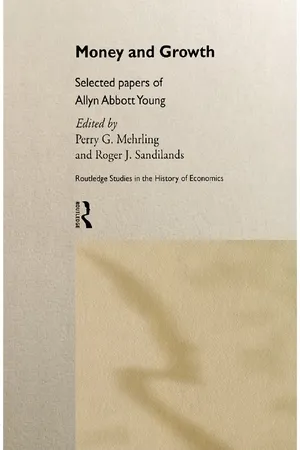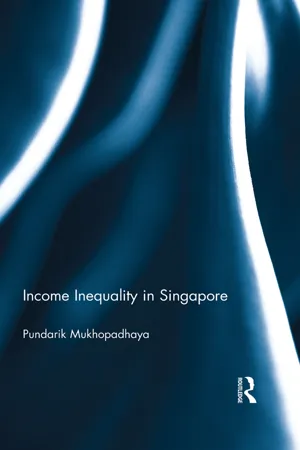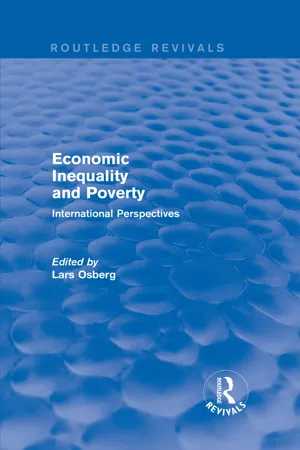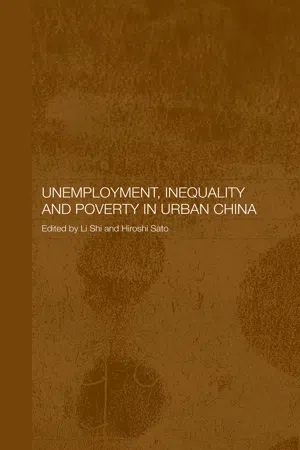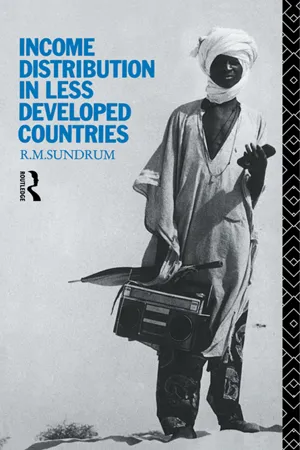Economics
Lorenz Curve
The Lorenz Curve is a graphical representation used to illustrate income inequality within a population. It compares the cumulative share of income received by a specific percentage of the population to the cumulative percentage of the population. The greater the distance between the Lorenz Curve and the line of perfect equality, the greater the income inequality.
Written by Perlego with AI-assistance
Related key terms
Related key terms
1 of 4
Related key terms
1 of 3
10 Key excerpts on "Lorenz Curve"
- eBook - ePub
- Perry G Mehrling, Roger J Sandilands(Authors)
- 1999(Publication Date)
- Routledge(Publisher)
Putting the same facts in another way, it would appear, according to the statistician, that the most prosperous 1 per cent among the income receivers got nearly 16 per cent of the total income; the most prosperous 10 per cent received about a third of the total; the group including the most prosperous fourth of all income receivers got about 50 per cent of the total income. Put in this way, the statistics may seem to indicate that income is concentrated to an alarming degree in relatively few hands. But a closer inspection of the facts gives them a different color. That prosperous 1 per cent of all income receivers includes all persons who get more than $25,000 per year. To get the most prosperous 9 per cent of the income receivers, we have to include everyone who has an income more than $5000. The most prosperous 30 per cent includes persons who are getting incomes of $3000 or a little less, and the most prosperous 60 per cent includes persons who are getting incomes slightly under $2000. All of these figures are summarized in what is called the “Lorenz Curve,” so named because it was first used by Dr M. O.Lorenz, statistician of the Interstate Commerce Commission. Both the vertical and horizontal scales represent per cents ranging from zero to 100. The horizontal scale corresponds to income receivers, the vertical scale measures per cents of the sum of all incomes. Thus, for example, a point which we may take arbitrarily, such as the point located by measuring three squares toward the right on the horizontal scale, and two squares upward on the vertical scale, would indicate both 30 per cent of all income receivers and 20 per cent of all incomes. Now it is clear that if all incomes were of exactly equal size, 10 per cent of the population would have 10 per cent of the income, 40 per cent of the income receivers would have 40 per cent of the total income, etc. So the “line of equal distribution” on the diagram would represent this hypothetical situation, for the points through which it passes are equal distances from both the vertical and the horizontal scales. The actual distribution of incomes in 1924 is indicated by the curved line on the chart. The extent to which this line departs or curves away from the line of equal distribution may be taken as an index of the degree of inequality of the distribution of incomes in the country.The defect of this Lorenz Curve is that it lends itself to misinterpretation. Like the tables of the cumulative distribution of incomes on which it is based it compares actual distribution of incomes with an impossible and really absurd state of affairs in which every person gets just as much income as every other person. A dead level of equality in the distribution of incomes is an impossible ideal. It is hardly ever urged even by extreme radicals. Some measure of inequality is necessary by reason of differences in ability and in energy. Incomes in an ideal state need not, perhaps, be absolutely proportionate to ability only, but there must at least be differences enough to serve as prizes or incentives for the abler and more energetic. - eBook - ePub
- Nan de Graaf, Dingeman Wiertz(Authors)
- 2019(Publication Date)
- Routledge(Publisher)
Figure 7.1 . This curve essentially plots how much of the total national income is earned by the poorest X percent of the country’s population. If income is distributed completely equally across all citizens, the curve will be a straight diagonal line: e.g., the poorest ten percent of the population earn ten percent of the national income, the poorest 50 percent earn 50 percent of the national income, the poorest 90 percent earn 90 percent of the national income. The larger the degree of curvature of the Lorenze curve, the more unequal the income distribution: e.g., the poorest ten percent of the population earn 0.0001 percent of the national income, the poorest 50 percent earn one percent of the national income, the poorest 90 percent earn three percent of the national income (leaving 97 percent of the national income for the richest ten percent). As such, the Lorenz Curve provides a convenient way of eyeballing how much inequality there is within a group, a society, or across a selection of countries.Figure 7.1 The Lorenz Curve and the Gini coefficientThe Gini coefficient or Gini index , in turn, provides a quantitative measure of inequality. It ranges from zero to one, where zero corresponds to a situation of complete equality (sticking to the example of the income distribution within a country, this would mean that every citizen earns the same income) and one corresponds to a situation of complete inequality (one citizens earns all of the income and everyone else earns nothing). In between zero and one, higher values correspond to a greater degree of inequality. Therefore, the Gini coefficient can broadly be interpreted as the percentage of national income that needs to be redistributed in order to achieve a perfectly equal distribution.The Gini coefficient bears a direct relationship to the Lorenz Curve. That is, it can be calculated by dividing the size of area A (i.e., the area between the diagonal line of equality and the Lorenz Curve) by the sum of areas A plus B; see Figure 7.1 . In equation form: Gini = A / (A + B) - eBook - ePub
- Pundarik Mukhopadhaya(Author)
- 2014(Publication Date)
- Routledge(Publisher)
i , we haveAlternatively,(2.42) is the mathematical representation of the Lorenz Curve.(2.43) The Lorenz Curve is an attractive presentation of income distribution. In the case of complete equality the curve will attainxi=ni, and for complete inequalityxi= 0 forni≠ 1 andxi= 1 forni =1. The convexity of the curve is an indicator of the deviation of actual income distribution from one of complete equality. Thus from the graphical representation of the Lorenz Curve, a measure of inequality can be derived as a ratio of the area between the curvesxi=niandxi=φ(ni )to the area under the curvexi=ni. The later area is obviously half as it is half of a square having length and width both as one. It can be proved that the Gini coefficient is twice the above-mentioned measure of inequality. Thus it can be said that if the Lorenz Curvexi =φ(ni )is specified the Gini coefficient is:(2.44) For the case of discrete income distribution the Gini coefficient can be calculated by taking the area of the polygon with vertices (0, 0), (F(t 1 ), G(t 1 )),…, (F(tk ), H(tk )). Thus the total area below the Lorenz Curve can be expressed as:From this, the definition of the Gini coefficient can be written as:(2.45) with some manipulation this formula turns out to be:(2.46) (2.47) For calculating the Gini coefficient for discrete income distribution, this formula will be used in empirical calculations. Also for the calculation of the concentration coefficient of component g the same procedure may be used.41For many purposes the Lorenz Curve is a useful device for comparison of various income distributions. Comparisons between two Lorenz Curves would indicate unequivocally which distribution is more equal (the distribution for which the Lorenz Curve is more nearer to the egalitarian line is the more equal). In mathematical terms dominance will be indicated. This will be discussed in further detail in Chapter 7 - eBook - ePub
Modern Labor Economics
Theory and Public Policy (International Student Edition)
- Ronald G. Ehrenberg, Robert S. Smith(Authors)
- 2017(Publication Date)
- Routledge(Publisher)
share of total earnings or income received by those in each group.Figure 15A.1 Lorenz Curves for 1980 and 2002 Distributions of Income in the United StatesSuppose that each household in the population has the same income. In this case of perfect equality, each fifth of the population receives a fifth of the total income. In graphic terms, this equality can be shown by the straight line AB in Figure 15A.1 , which plots the cumulative share of income (vertical axis) received by each quintile and the ones below it (horizontal axis). Thus, the first quintile (with a 0.2 share, or 20 percent of all households) would receive a 0.2 share (20 percent) of total income, the first and second quintiles (four-tenths of the population) would receive four-tenths of total income, and so forth.If the distribution of income is not perfectly equal, then the curve connecting the cumulative percentages of income received by the cumulated quintiles—the Lorenz Curve —is convex and lies below the line of perfect equality. For example, in 2002, the lowest fifth of U.S. households received 3.5 percent of total income, the second fifth received 8.8 percent, the third fifth 14.8 percent, the next fifth 23.3 percent, and the highest fifth 49.7 percent. Plotting the cumulative data in Figure 15A.1 yields Lorenz Curve ACDEFB . This curve displays the convexity we would expect from the clearly unequal distribution of household income in the United States.Comparing the equality of two different income distributions results in unambiguous conclusions if one Lorenz Curve lies completely inside the other (closer to the line of perfect equality). If, for example, we were interested in comparing the American income distributions of 1980 and 2002, we could observe that plotting the 1980 data results in a Lorenz Curve, AcdefB in Figure 15A.1 - eBook - ePub
Economic Inequality and Poverty
International Perspectives
- Lars Osberg(Author)
- 2017(Publication Date)
- Routledge(Publisher)
x Lorenz-dominates y ). And this has been formally proven:(T1) For any two arbitrary distributions x, y, with the same number of members and μx = μy , whose members are ranked by income to give ordered distributions x' and y' respectively, then x' is obtained from y' by a finite sequence of progressive transfers if and only if x Lorenz-dominates y.The result is particularly useful because the condition on Lorenz Curves is so easily checked. The problem is, of course, that inequality comparisons will be indecisive wherever Lorenz Curves cross (see the dotted line in Figure 1.5 ), and the result cannot be applied where the distributions have different means. Before considering some of the strategies adopted as a consequence of this, it will be fruitful to redevelop the results within a different framework.Social Welfare, Inequality Rankings, and Lorenz Curves
Those familiar with welfare economics will know that it is standard practice to evaluate the desirability of policy outcomes in terms of their effects on social welfare. This in turn is measured by using some form of social welfare function (SWF) to aggregate outcomes across all persons in the population. It has been seen in the preceding sections that different inequality measures incorporate different systems for weighting individual incomes, and so in this sense are just like some form of SWF. This suggests that an alternative approach could be to start with a SWF, specified to incorporate certain social values, and then to derive an inequality measure from this, knowing that it must reflect these same properties. - Hiroshi Sato, Shi Li(Authors)
- 2006(Publication Date)
- Routledge(Publisher)
Figure 4.1 indicates that the 1988 Lorenz Curve dominates that of 1995, which in turn dominates that of 1999. This again confirms that income inequality increased over the period.To understand whether the increase in income inequality affected social welfare over the period studied, Figure 4.2 presents the generalized Lorenz Curve for 1988, 1995 and 1999 (left-hand side) and the difference between the curves of 1988 and 1995 and the curves of 1995 and 1999 (right-hand side). The vertical axis represents the cumulative percentage of per capita household income multiplied by the mean. It shows the total resources being accessed by each percentile of the population. If one generalized Lorenz Curve lies everywhere above another, it is said that the higher curve is preferable to the lower curve with regard to social welfare as every percentile of the population distribution has access to more resources.Figure 4.2 (A) illustrates the comparison between the 1988 and 1995 distributions. It is clear that although income inequality had increased by 1995, the income growth over the period more than compensated for the inequality increase, as social welfare in 1995 is everywhere greater than in 1988.Figure 4.1 Lorenz Curves for real per capita household disposable income, 1988, 1995 and 1999.Figure 4.2 Generalised Lorenz Curve. (A) 1988 and 1995. (B) 1995 and 1999.Figure 4.2Figure 4.3 Distribution of households with unemployed members across income deciles.- eBook - ePub
World on the Move
Consumption Patterns in a More Equal Global Economy
- Paolo Mauro, Tomas Hellebrandt, Jan Zilinsky(Authors)
- 2016(Publication Date)
figure 3.1 and the Gini index equals 100.Use of Income or ConsumptionIn an ideal world, all countries would survey households on a consistent basis, using identical concepts and methodologies, so that survey results would be directly comparable across countries. In the real world, household surveys are not designed by national statistical agencies with international comparability in mind.The analysis here uses the best survey data available, primarily from the Luxembourg Income Study (LIS), which collects income survey data on a large number of middle- and high-income countries; harmonizes them to enable cross-national comparisons; and makes them available for public use. Information on countries not covered by the LIS is obtained from the World Bank database, which is based largely on consumption surveys. This mixing of income and consumption surveys is far from ideal, but given data constraints it has become the standard approach in the literature.1Figure 3.1 The Lorenz Curve and the Gini indexSource:Source: Authors’ illustration.There are good practical reasons why some countries survey household incomes and others survey consumption. As Angus Deaton (2005 , 5) notes, “consumption is typically much easier to measure in surveys than is income in poor countries, where many people are self-employed in agriculture, whereas the opposite is true in rich countries, where most people are wage earners and are more reluctant to cooperate with time-consuming consumption surveys.” Combining income and consumption data, although questionable in principle, can therefore potentially increase the accuracy of cross-country comparisons of inequality and estimates of the global distribution of individual living standards. (For a description of the sources of the household survey data used in this chapter, see appendix 3A - eBook - ePub
- Renato Cirillo(Author)
- 2012(Publication Date)
- Routledge(Publisher)
The Lorenz Curve admittedly differs from the Paretian distribution but the divergence of the Pareto coefficients from the Lorenz coefficients could be explained by the fact that Pareto was merely concerned with only a special range of incomes, i.e. the extreme tail of high incomes. If one keeps this in sight, one could understand that the feature of Pareto’s coefficient, which can vary from 0 to 2, is only a measure of the degree of ‘peakedness’ (kurtosis) of the distribution. Nevertheless, this feature is in a sense misleading. Its constancy does not reflect the ability of society to alter its inequality of wealth or income, but rather it ‘merely reflects the overlooked fact that Pareto’s coefficient is an insensitive measure of true changes in equality’. 32 This recent explanation has considerably helped scholars to give the right interpretation to Pareto’s Law and, thus, avoid much confusion. To summarize: there is much in the ‘Law’ which could be criticized. Pareto overlooked, for example, the significance of the changes in the distribution of personal income from country to country and from time to time. Yet no one has yet produced a satisfactory explanation as to why income distribution over a long period of time shows a striking stability. Pareto’s reasons for the inequality of incomes are not considered valid any more. Other more appropriate indexes of inequality have been produced; yet his method was the first one ever conceived with this aim; and in spite of its weakness, it is at least still a good yardstick for comparisons between different places and epochs. Moreover, his definition of x remains a useful index of economic welfare. Finally, irrespective of the divergent views we might hold of Pareto’s Law, the best service we can render to economics is to treat it, at least, with the respect it deserves. In the words of D.H - eBook - ePub
- R. M. Sundrum(Author)
- 2003(Publication Date)
- Routledge(Publisher)
c – b the corresponding measure for higher incomes. We can then measure the pattern of inequalities in the distribution by the ratioTable 3.4Correlation of inequality measures with Gini indexFigure 3.8In terms of the diagram in Figure 3.4 , where P represents a given distribution and E the corresponding egalitarian distribution, the quantity w is indicated by the slope of the line joining P to E. Therefore this measure represents a different aspect of income distribution from overall inequality, which is represented by the distance PE for the Hirschman index and the horizontal distance between P and E for the Gini index.A more sophisticated measure of this aspect of income distributions has been suggested by Kakwani (1980: Chap. 17). Starting from the Lorenz Curve of Figure 3.3 , he makes a transformation of co-ordinates such that the diagonal becomes the horizontal axis; then the Lorenz Curve may have different shapes, as illustrated in Figure 3.9 .In this diagram, the curve in Figure 3.9a is skewed towards the point (0, 0) and may be said to be negatively skewed, while the curve in Figure 3.9b is skewed towards the point (1, 1) and may be said to be positively skewed. To measure the extent of skewness, Kakwani uses the ratio of the parameters α and β of the beta-distribution fitted to the Lorenz Curve after transforming it as described above. This measure of the skewness of the Lorenz Curve is closely related to the measure w defined above. The average values of the two measures for various groups of countries are shown in Table 4.2 - No longer available |Learn more
- Robert S. Rycroft(Author)
- 2017(Publication Date)
- Routledge(Publisher)
Table 1.1 ’s listing of the share of household income received by each quintile in 2015. The right-hand column shows the cumulative share of income. The cumulative share percentage for a quintile measures the percentage of income earned by that quintile plus all lower quintiles. In 2015, the cumulative share value for the lowest quintile is 3.1 percent, exactly the percentage of total income earned by the quintile. The cumulative distribution value for the second quintile is 11.3 percent, which is equal to the 3.1 percent earned by the lowest quintile plus the 8.2 percent earned by the second quintile. The 25.6 percent cumulative share for the third quintile is the 3.1 percent of the lowest quintile plus the 8.2 percent of the second quintile plus the 14.3 percent of the third quintile. The remaining cells are filled in similarly.Next, plot the cumulative share for each quintile. Finally, connect successive points with straight lines. The result is Figure 1.4 .A Lorenz Curve based on five quintiles is an approximation of the true Lorenz Curve. As the number of income categories increases, the curve becomes more precise and more “curved.”Table A.1 Share of Aggregate Income and Cumulative Share of Income Received by Each Quintile of Households, All Races: 2015Households Share of Income Cumulative Share of Income Lowest quintile 3.1% 3.1% Second quintile 8.2 11.3 Third quintile 14.3 25.6 Fourth quintile 23.2 48.8 Highest quintile 51.1 100.0 Source: United States Bureau of the Census, www.census.gov/data/tables/2016/demo/income-poverty/p60-256.html Table 1 (accessed October 5, 2016)In the case of perfect equality, each quintile would earn 20 percent of the income. The cumulative distribution values by quintile would be 20 percent, 40 percent 60 percent, 80 percent, and 100 percent. Graphing these would give a 45° line. The case of perfect inequality can also be constructed. Here the lowest, second, third, and fourth quintiles would earn 0 percent and the highest quintile would earn 100 percent. The cumulative distribution values would be graphed along the bottom horizontal axis up until 100 percent of the families. Then a vertical line would shoot up to the upper right-hand corner.Figure A.1 The Lorenz Curve, 2015The Gini coefficient is relatively easy to approximate just remembering a few geometrical formulas. Referring to Figure 1.5 , notice that area (A+B) is simply a triangle. The area of a triangle is ½ b *h , where b is the base of the triangle and h is the height. Area A might be difficult to compute directly, but it can be obtained indirectly. Notice that area B consists of five sub-areas. To see that more easily, view Figure A.1 . Call the five sub-areas H, I, J, K, and L. Area H is a triangle. Areas I, J, K, and L are rhombuses. The area of a rhombus is ½ b *(h 1 + h 2 ), where h1 is the height of the left-side of the rhombus and h2
Index pages curate the most relevant extracts from our library of academic textbooks. They’ve been created using an in-house natural language model (NLM), each adding context and meaning to key research topics.
Explore more topic indexes
Explore more topic indexes
1 of 6
Explore more topic indexes
1 of 4
